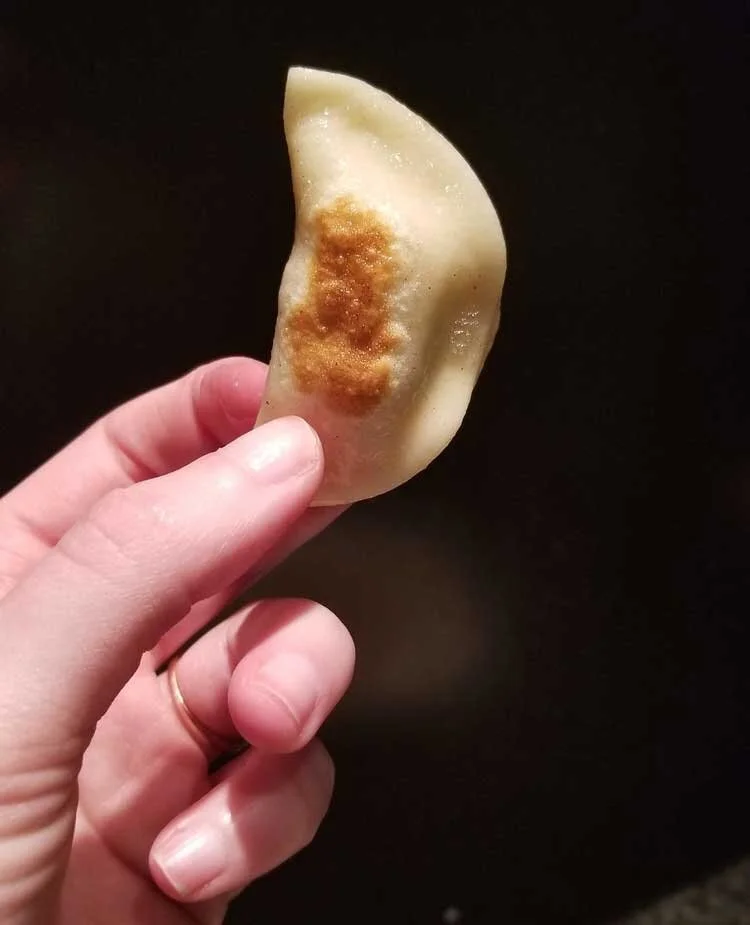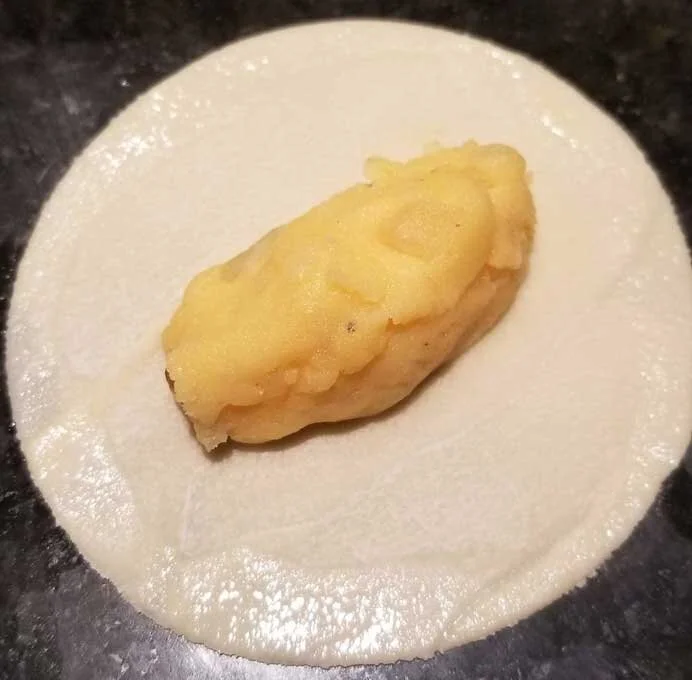Perogy (or pierogi, pirohy, pyrhoy, etc) is a food from Central Europe that is especially popular in Russia and the Ukraine. Since we’re Canadian (and almost every Canadian will tell you that they have some sort of claim to being Ukrainian) we decided to tackle making perogies, as it is a dish that is near and dear to our hearts. ❤️
If you’re unfamiliar with what they are, think Chinese dumplings. If you’re unfamiliar with those, think ravioli. All three of these foods are comprised of a filling wrapped in dough. Essentially, perogies are Ukrainian ravioli. Because of the similarities to ravioli and dumplings there are many myths surrounding their origins and who may or may not have brought them to Europe hundreds of years ago. But, instead of focusing on folklore, let’s focus on these delicious potato based dumplings.

How to Make Perogy Dough
Perogy dough is as simple as you can get! Four ingredients are all you need to start your perogy adventure. 🥟
Ingredients:
3 cups of flour
2 eggs
1 tsp salt*
1 cup water**
*Just eyeball this, a pinch or so should be fine.
**We used water that the potatoes had been boiled in for extra starchiness.
Whisk the eggs, add salt and water, and then mix well with the flour. Knead the dough for 7-10 minutes or until the dough is soft, smooth, and bounces back when you poke it with your finger. Wrap the dough in plastic wrap and let it sit for at least a half hour to give it a chance to relax.
Once the dough is finished its nap, unwrap it and begin to roll it out with a rolling pin on a floured surface so it doesn’t stick. We recommend working with the dough one quarter at a time — trying to roll out the whole thing all at once will become a major pain in the butt very rapidly.
🍝 Mediocre Tip: If you have a pasta machine, use it! It’s the same principle as pasta dough.
When your dough is at an acceptable thickness (apparently ⅛ of an inch is a pretty standard thickness), use a cup, ring mould, or a round cookie cutter to cut out circles of dough. Now you’re ready to fill your perogies!
Perogy Filling Ideas
Perogy filling is super easy to make — just mash some potatoes and add whatever you want to it. Classic combinations include:
Cheddar and onion
Roasted garlic
Cheese and bacon
Bacon, sauerkraut, and onion
Spinach and feta
All of the cheeses

There are also dessert perogies, but we won’t get into that in this post. Dessert perogies are essentially just mini handheld pies, so you can put any pie filling in them! (Think blueberry or apple — apparently prune is really popular too.)
Anyways, back to savoury perogies — if it mixes well with mashed potatoes, you can put it in a perogy. Here’s how to make the filling:
Peel and cut potatoes into evenly sized pieces.
See Also35+ Best Instant Pot Recipes!Put potatoes in a pot and fill with water, covering the potatoes.
Boil potatoes. Poke potatoes to test tenderness.
Once tender, drain the water. (If you haven’t made your dough yet, reserve a cup to use for your dough!)
Hope you have enough potatoes for the amount of dough you made. (It’s okay — you probably have too much.)
Mash your potatoes.
Add your flavourings. If adding cheese, add it while the mashed potatoes are still hot so it’s easy to incorporate and melts. Adding salt and pepper is also recommended here.
🥔 Mediocre Tip: When making the filling, you can save some time by using a hand blender to mash the potatoes instead of mashing them with a potato masher. Your arms will thank you!
Angry Reader: “What, you’re not giving me measurements for my perogy filling?”
No! Perogy filling is a great time to experiment and make what suits your tastes. For example, a lot of perogy recipes we looked at called for a ratio of 3 cups mashed potatoes to 1 cup of cheddar cheese. We tried it, and it wasn’t cheesy enough, so we added 2 cups instead. If you have leftover filling, freeze it for next time or enjoy eating your fancy mashed potatoes on their own!
Be your own personal perogy Jesus.
How to Shape Your Perogies
Once you have your dough circles cut out and your filling ready, it’s perogy assembling time! Here are the Mediocre Chef approved steps to assembling a perogy:
Place approximately 1 teaspoon of filling in the center of the dough circle. (Add enough to fill the perogy without overstuffing.)
Dip your finger in a bowl of water and wipe the water around the rim of the dough circle.
Gently fold the dough circle in half, ensuring that the filling is spread throughout the perogy, but there is room for the edges to seal.
Gently pinch to seal the perogy shut. (You may need to rub more water on the seam to glue it shut.)

If you’ve never made perogies, ravioli, or dumplings before, then it may take a few attempts before you make the perfect perogy. Just work carefully and adjust the amount of filling so that it works for you!
How to Cook Perogies
The traditional method of cooking perogies is to boil them until they float, then tossing them in butter to coat. We prefer to boil ours, then fry them in some butter and oil to give them a nice golden brown color and to get them a bit crispy, but we respect the just boil and butter method as well.
🥓 Mediocre Tip: If you cooked bacon to go along with your perogies, you can fry them in the leftover bacon fat for extra bacony goodness!
When boiling your perogies, don’t add too many to the pot — you don’t want them to crowd and stick together. Also be sure to give them a little stir to ensure they don’t stick to the bottom of your pot!

What Do You Eat With Perogies?
Perogies can be served with a myriad of things — the most common way to eat them is with sautéed onions and sour cream. If sour cream isn’t your thing, that’s cool. Other ways to serve perogies include:
Bacon bits and green onion
Garlic and onions
Salsa and more cheese (think nacho perogies)
Perogies go great with pickled beets, sauerkraut, kielbasa, and cabbage rolls!
How do you like your perogies? 🥟 Let us know in the comments below!
Want to read more? Check out these 7 Easy Dinner Recipe Ideas or our Bachelor’s Guide to Cooking.

Vegetarian Recipes, How-To's
Mediocre Chef
15 Comments
